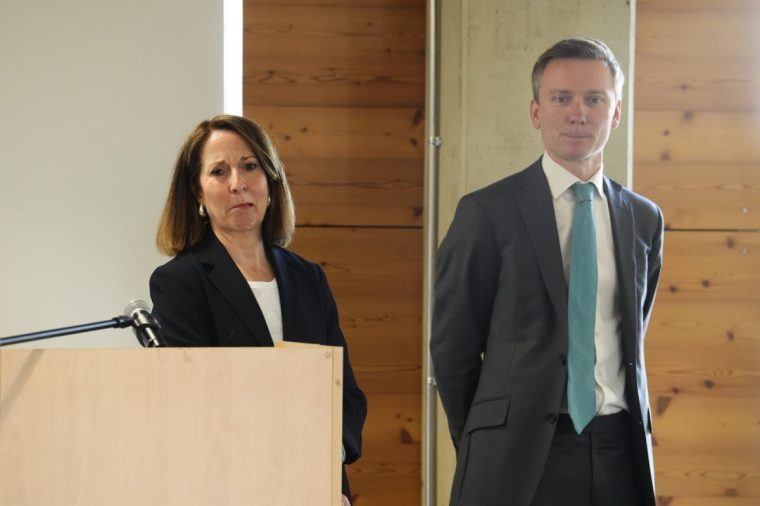People are not saving enough into their pensions and could be left financially struggling when they come to retirement, the Government has warned.
It has issued stark figures to back its claim. According to the Treasury and Department for Work and Pensions, retirees in 2050 are on course for £800 or 8 percent less private pension income than those retiring today.
The Government says four in ten – or almost 15 million people – are not saving enough for retirement, with 45 per cent of working-age adults saving nothing at all.
To tackle this, ministers have brought together experts – through the Pensions Commission – to consider how people can be encouraged to save more.
Work and Pensions Secretary Liz Kendall said the commission would report in 2027 with plans that will look as far forward as 2050.
But what changes are realistically on the cards?
Minimum contributions
One of the policies that has been discussed by pension experts is whether the minimum contributions paid into pots could be changed.
Currently, under the auto-enrolment scheme, employers must contribute 3 per cent and employees pay in 5 per cent – an 8 per cent contribution in total – into a workplace pension. For most, this is calculated based on total earnings between £6,240 and £50,270 a year before tax.
Increasing this minimum payment, either for employers or staff, would be a relatively simple and broad way of increasing the size of pensions.
But it would also create additional financial burdens for companies and for employees, and does not solve the issue of those on lower incomes who opt out of pensions entirely due to financial pressures.
Senior research economist at the Institute for Fiscal Studies (IFS), Heidi Karjalainen, has suggested that increasing contributions for middle or higher earners only would achieve the right balance.
Research shows that high and middle income earners are more likely to fail to reach the “adequacy benchmark” of retirement income – because their pensions will be worth so much less than the income they are used to,” she told The i Paper.
“For higher earners, they have to build up a lot more private savings to get to a target replacement rate,” she said.
“It is also true that lower earners struggle with low take-home pay, and it’s not necessarily the right call for them to be putting more money into their pension. So that’s why we are suggesting increasing minimum contributions, but only aimed at people with higher earnings or any period where people have higher earnings.”
She suggested increasing the contribution to a total of 10 per cent, but increasing the earnings lower limit from £6,240 to £9,000.
Pensions minister Torsten Bell has previously expressed support for looking at the contribution rates. In a book, published before he was elected MP, he wrote that the default contribution rates for both employers and employees should gradually rise to 6 per cent.
Ministers have ruled out changes to the minimum pension contribution this parliament – until 2029 – but this could change in future years.
Business bosses have raised the alarm over the impact this could have on smaller firms, warning that firms are already buckling under employment costs, and have stressed the importance of long-term planning for any changes that could add to the burden felt by companies.
A former government source – who was in the Tory administration – told The i Paper that increasing minimum contributions would probably be the most effective change, but “is politically very difficult if increasing the cost of doing business”.
Likelihood: 4.5/5 – It seems almost inevitable that there will be an eventual change to the minimum contributions but this is likely to be phased over time.
Auto-enrolment  Work and Pensions Secretary Liz Kendall and Pensions Minister Torsten Bell (Photo:Jordan Pettitt/PA Wire)
Work and Pensions Secretary Liz Kendall and Pensions Minister Torsten Bell (Photo:Jordan Pettitt/PA Wire)
In the current system, an employer must automatically enrol any employee aged 22 or over, and earning at least £10,000 a year, into a pension scheme. This is called auto-enrolment.
But if someone opts out of having a pension they – and their employer – make no contributions.
The IFS has suggested that those on lower earnings, who are not paying into their pension themselves, should still be entitled to an employer contribution.
Ms Karjalainen said: “You only get the 3 per cent employer contribution if you’re also saving into a pension yourself. So what we suggest is that you should have an employer contribution that’s non-contingent, so you would get that regardless of what you decide to do about your own savings.”
There would, of course, be an increased cost to employers for this. But she argued that if these changes were phased in over time, firms would not have to take a sudden financial hit.
“It is true that if you want more private savings, that has to come from somewhere. We make it very clear that these changes should be phased in,” she said.
“There is also evidence that shows higher pension contributions do lead to slower wage growth. So again, it wouldn’t actually necessarily be a hit on employers if it’s done that slowly over time.”
The Government has said that it would not change contribution rates during this parliament. But ministers have remained open to a longer-term phased approach that could set out a route for contributions to change in the future.
Some also argue that the age for auto-enrolment should be lowered, to encourage younger people to start saving earlier in their working lives.
But there is some hesitancy among politicians about whether this would have a detrimental impact on those starting out who are not earning very much money.
A Tory source told The i Paper any change to the age “would need to be considered carefully given the cost of living pressures faced by young people”.
They also raised the issue of financial education – or a lack of understanding about pensions – as being one of the root causes of undersaving.
The long-awaited pensions dashboard, due to go live next year, would help people to understand and keep track of their pensions, the source said.
Likelihood 3/5 – There is political nervousness about putting more pressure onto businesses or young and lower earners. While tweaks to auto-enrolment are on the cards, any significant changes would be carried out cautiously and gradually.
Sidecar savings or early access to pensions
Workers can currently draw down their pension savings at 55 – 25 per cent of it tax-free. The age will increase to 57 from 2028, and the Government has vehemently denied reports it would consider allowing people to draw down from their pensions at a younger age.
But a slightly different policy – known as sidecar savings – will be considered by the commission.
The savings would be linked to a pension but, unlike a retirement fund, could be accessed early to help in a financial emergency.
They are designed to help those on lower incomes save more money without fearing they would not have access to it in a financial shock.
Bell previously suggested these accounts could be capped at £1000.
And Government sources have pointed to recent trials where employees can set up their own savings pot, which overflows into their pension once a financial target has been met. The research found that the tool was popular among those with low financial security.
A Conservative Party source said the party broadly welcomed the policy and anything that would encourage greater savings contributions and financial resilience.
In particular, there is a growing political consensus that a sidecar savings policy would help the self-employed – a growing group in the UK, who are less likely to have a healthy pension – to set aside money.
Likelihood: 4/5 – The Government has not been steering away from introducing a tool similar to sidecar savings pot and they are particularly keen to increase pensions for self employed people – who could benefit from such a policy.
Pension age
The Government has launched its statutory review of the state pension age which will consider whether the planned rise – from 66 to 67 by 2028, and then to 68 by 2046 – should be sped up, or slowed down or left as it.
Sources have indicated that there is unlikely to be a change in the current state pension age trajectory announced before the next General Election.
But it remains a live issue. Is delaying retirement the best way to ensure people have enough money to sustain them when they are no longer working?
Elaine Smith, the Interim Deputy Director for Work at the Centre for Ageing Better, argued that the focus should not be on delaying retirement age but on improving the incomes of those working later in life before they claim their pensions.
“Before any further changes are made to the state pension age, it is right that the DWP undertakes a holistic review of its approach to people working in their 60s,” she told The i Paper.
“This means considering additional financial support for those approaching state pension age who cannot work, and employment support for those above state pension age who want and need to work.”
She also argued ministers should be considering early access to pension benefits for those approaching retirement age and are unable to work – a growing challenge for the Government – as well as more generous and accessible working-age benefits.
A Liberal Democrat source told The i Paper there were too many people facing financial insecurity after work – but argued shortening retirement was not the answer and pointed to stalling life expectancy as justification for this view.
Likelihood: 1/5 – While the state pension age will most likely rise eventually its unlikely the Government would choose to accelerate this transition.
Incentives to save
Kendall and Chancellor Rachel Reeves have both said they want to increase investment opportunities for existing pension pots to make them as valuable as possible.
Better investment would not only increase the size of the pots but would also incentivise those who can save more to do so.
Ministers have already announced reforms – through the Pension Schemes Bill – which will create more pension “megafunds”.
This will provide the pension funds with much larger amounts of capital to invest in infrastructure projects and private businesses in the UK – a plan designed to help the economy and savers simultaneously.
A focus on better investment is not only something supported by Labour politicians.
A Liberal Democrat source said delivering good returns for savers and “new ideas incentivising pension funds to invest more productively” should be top of the list of reforms.
But a Tory source said they had reservations about forcing pension funds to invest in the UK – arguing that it should be a choice, not mandated.
The Bank of England governor, Andrew Bailey, has also stated his opposition to mandating.
The i Paper understands the Conservative Party is also looking at whether contradicting Government policies – such as taxes, or means testing of certain things – are actually stopping people from saving more, even if they can enjoy positive returns.
Likelihood: 5/5 – The Government has already begun the process of revamping investment opportunities for pension funds.
